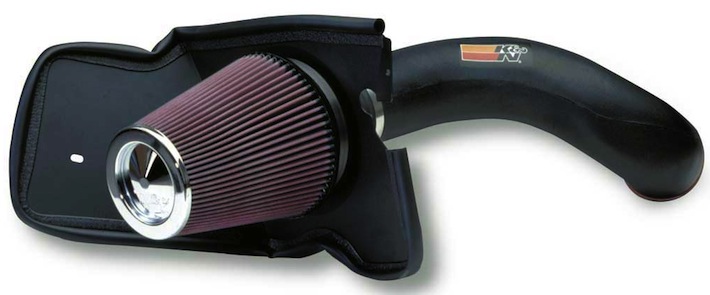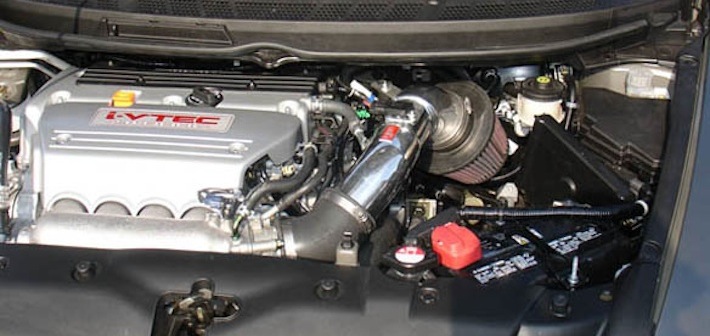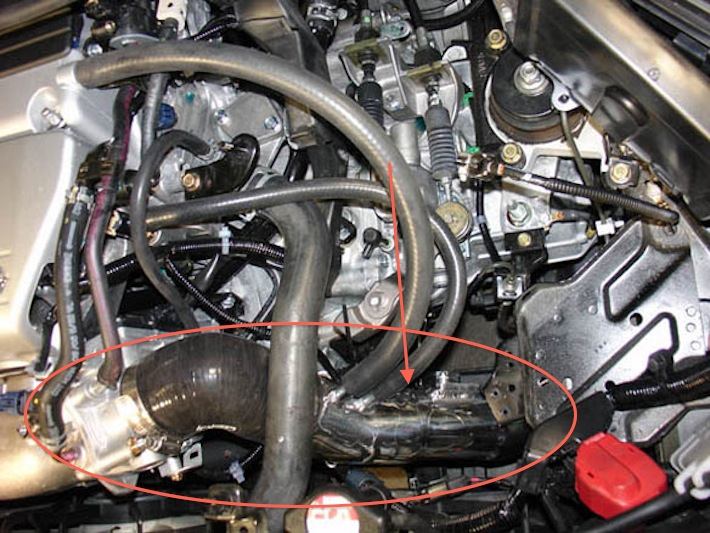
We get this question a lot. People ask us the pros and cons and which is better daily. We decided to create an article about this topic to better explain the differences with intakes, which we recommend, and which would be right for your vehicle or performance needs. We will be adding to this as new technology comes out, so please check back often, or add a comment about how a short ram intake or cold air intake has worked for you.
What is the difference between a cold air intake and a short ram intake?
As the name implies, a short ram intake is "short". Due to it's size, the intake pipe doesn't stretch far away from the intake manifold, so the air filter remains somewhere near the engine. A cold air intake has longer piping, and is designed to push the air filter away from the engine into an area that has colder air, hence the name cold air intake. Typically, since the cold air intake draws in cooler air it usually makes more horsepower than a short ram. However, depending on engine design, this isn't always the case, and we'll explain further below. A short ram intake is generally less expensive as well, and easier to install and service since the air filter is typically easy to see when you pop the hood. A cold air intake is longer, and places the air filter farther away, sometimes in a fender, so installation is more difficult as is service, and is usually more expensive.
Short Ram Intake
The short ram intake is generally designed to replace your stock air box. Most stock cars come with a plastic box with a plastic hose connected to the throttle body (or directly to the turbo). A performance aftermarket short ram intake typically has a hard pipe made of aluminum that replaces the stock rubber pipe, and the stock air box is replaced with a open element air filter. This generally gives you a good power increase over stock because you are replacing the restrictive air box with an open element air filter, and replacing the rubber hose (which is usually accordion like on the inside) with a smooth metal pipe. Most quality short ram intakes are calibrated through design to keep the stock air/fuel mixtures the same as stock to not throw any check engine lights. Sometimes a manufacture won't offer a cold air intake when their research shows it doesn't increase power over a short ram intake.
Cold Air Intake
A cold air intake is designed to place the air filter as far away from the hot engine as possible. Especially important when your radiator fan turns on, it will not blow the hot air into your air filter as with most short rams. Some manufactures make the cold air intake so that it places the air filter inside a fender or under a fender to try and capture as much cold air as possible. When an engine takes in colder air, it's packed with more oxygen, and creates more power. When a intake manufacture tests the intake, they test different air filter locations to see which is the coolest location. This usually creates more power over a short ram, but due to the location the air filter gets dirty faster, is harder to install, and harder to maintain when the air filter needs to be cleaned.
Do I need a bypass valve?
An air bypass valve is designed mainly for the cold air intake. Since the air filter is placed so low in the engine, it can suck up water when driving over a puddle or in heavy rains. If your intake sucks in water, the engine will likely hydro-lock, and be destroyed. A bypass valve attaches to your intake pipe, so that if the air filter does become submerged in water, the air will instead go to the path of least resistance, and get pulled in through the bypass valve, and usually not suck in any water. Highly recommended for rainy areas.
Which intake sounds better?
Usually a short ram intake would be louder, since the pipe is shorter in length and closer to the throttle body. A cold air intake isn't much quieter, but might sound a little less deep due to the air traveling a farther distance in the pipe and the pipe almost acting as a resonator. Both give your car a strong deep tone when on the throttle that is undeniably a modified sound that any enthusiast recognizes.
Are air boxes better than open element air intakes?
This really depends on your vehicle. Some vehicles are designed in a way that places the air filter in front of, or near the radiator. The problem with this is that the air filter will get hot air pushed into it when the radiator fan turns on. One way around this is to put the air filter into a box that blocks the air from the radiator fan from directly hitting the air filter. For vehicles with a design like this, an air box would be better. Keep in mind also that sometimes an open element air filter doesn't necessarily make more power than a properly designed aftermarket air box. The air box can also keep the air filter cleaner, requiring less maintenance.
Is it better to have an intake with a dry air filter or an oiled air filter?
This is up for strong debate. Manufactures that use oiled air filters claim they capture more dirt particles. Enthusiasts say that the oil in the air filter can get sucked through the filter, and clog the mass air flow sensor (MAF or MAS) and cause erratic readings. Now a days, most manufactures offer a dry filter that does not need to have oil applied to it. We have had good luck with dry filters, and don't see any need to go with an oiled filter if possible.
What are some short ram intake brands?
AEM Short Ram Intake
K&N FIPK Kit
Weapon R Secret Weapon Intake

Above you see an Injen Short Ram Intake installed on a 2007 Honda Civic Si. Notice how the intake remains in the engine bay. This is the stock location for the factory air box.

Above you see a cold air intake on the same 2007 Honda Civic Si. Notice how the air filter is not in the engine bay. We circled the intake pipe that runs from the throttle body down under the car into the driver side fender well. The arrow shows the intake pipe.
We hope you find this useful and it helps you decide which intake you want to purchase. You can see our catalog of short ram intakes or cold air intakes and if you have any questions, please leave a comment.






0 comments:
Post a Comment